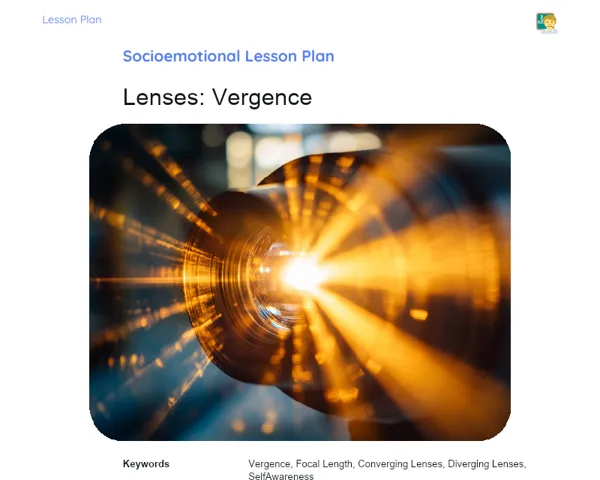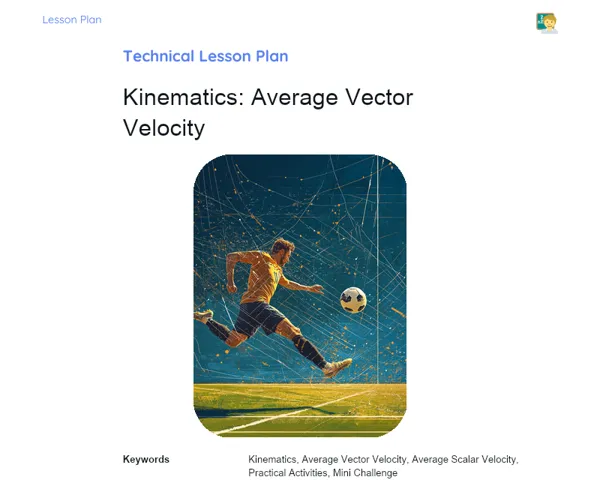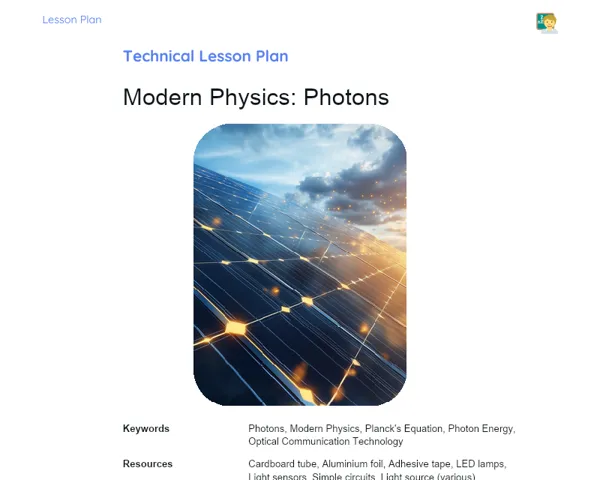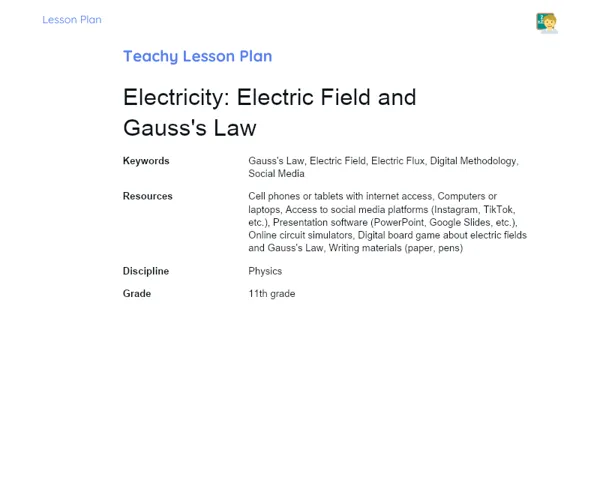Lesson Plan | Lesson Plan Iteratif Teachy | Waves: Doppler Effect
| Keywords | Doppler Effect, Apparent Frequency, Sound Waves, Active Methodology, Digital Tools, Interactivity, Practical Learning, Educational Games, Social Media, Scientific Investigation, Physics, High School |
| Resources | Smartphones with internet access, Computers or tablets with internet capability, Game development platform (e.g., Scratch), Video and audio editing applications (e.g., Audacity, Instagram), Sound recordings (sirens, aircraft, etc.), Instagram profiles set up for class use, Projector or screen for presentations |
| Codes | - |
| Grade | 12th grade |
| Discipline | Physics |
Goal
Duration: 10 - 15 minutes
This stage aims to furnish students with a clear and thorough understanding of the lesson's main objectives, equipping them to apply the theoretical concepts of the Doppler effect to practical problems and common situations, thus strengthening the link between theory and practical application.
Goal Utama:
1. Grasp the concept of the Doppler effect and how it applies to everyday life.
2. Calculate the apparent frequency heard by an observer based on the movement of the sound source and the observer.
Goal Sekunder:
- Connect the Doppler effect to observable phenomena, such as the sound of an ambulance or the usage of radar.
Introduction
Duration: 10 - 15 minutes
This step actively engages students and sparks curiosity about the topic. By seeking out fascinating facts and discussing them, students start to connect to real-life applications of the Doppler effect, laying a solid groundwork for the practical activities that will follow.
Warming Up
Begin by explaining to the class that the Doppler effect is a phenomenon that occurs when there's a change in how we perceive the frequency of a sound wave due to the relative motion between the source and the observer. To make this more interactive, encourage students to use their phones to find an interesting fact about the Doppler effect, like its relevance in speed radars or astronomy. Let them share their findings, spurring a brief discussion.
Initial Thoughts
1. What is the Doppler effect?
2. How does the movement of either the source or observer impact the perceived frequency of sound?
3. What are some everyday examples of the Doppler effect?
4. In what ways is the Doppler effect applied in various scientific and technological fields?
5. How can we calculate apparent and actual frequencies in a scenario involving the Doppler effect?
Development
Duration: 70 - 80 minutes
This stage intends to provide students with a practical, contextual experience of the Doppler effect, fostering active engagement through creative and digital tasks. The proposed activities allow students to collaboratively and playfully apply their knowledge, reinforcing their learning and making it meaningful.
Activity Suggestions
Activity Recommendations
Activity 1 - 🎮 The Doppler Effect Game
> Duration: 60 - 70 minutes
- Goal: Comprehend and apply the Doppler effect in a hands-on and interactive manner, utilising digital tools to create a tangible connection to the real world.
- Deskripsi Activity: Students will devise a mini-interactive game using an online game development platform, like Scratch or similar. The game should showcase different scenarios illustrating the Doppler effect, such as an ambulance passing a pedestrian or an aircraft flying over an airport.
- Instructions:
-
Split the class into groups of no more than 5 students.
-
Select a game development platform, such as Scratch or another easily accessible and user-friendly tool.
-
Ask groups to discuss and choose a scenario to represent the Doppler effect.
-
They should outline a storyline for the game, incorporating an introduction, tasks/interactions, and a conclusion.
-
Guide them to code in the change in sound frequency (Doppler effect) as the object moves in the game.
-
Allow ample time for development; encourage students to fine-tune and test their games.
-
Lastly, have each group present their game to the class, detailing how they depicted the Doppler effect and any obstacles they encountered.
Activity 2 - 📱 Sound Stories on Instagram
> Duration: 60 - 70 minutes
- Goal: Illustrate understanding of the Doppler effect using modern social media tools and multimedia resources to enhance engagement and context.
- Deskripsi Activity: Students will generate a series of Instagram stories that illustrate everyday situations where the Doppler effect can be seen. They will use videos, sounds, and texts to explain the phenomenon and demonstrate how the apparent frequency shifts with the relative movement of the source and observer.
- Instructions:
-
Divide the class into groups with a maximum of 5 members.
-
Instruct groups to pick one or more everyday scenarios where the Doppler effect can be observed, such as an ambulance siren or a moving train.
-
Students should film videos or utilise existing clips reflecting these scenarios.
-
Using video and audio editing apps, they should embed sound effects that represent the Doppler effect.
-
They must craft explanatory stories on Instagram, using videos, texts, and sound to illustrate the process and frequency change.
-
Each group should then publish their stories on a class-created Instagram profile and share with their peers.
-
Set aside time for everyone to view and comment on each other's contributions, leading to a final discussion about the concepts presented.
Activity 3 - 🕵️♂️ Doppler Mission: Frequency Hunters
> Duration: 60 - 70 minutes
- Goal: Employ theoretical concepts of the Doppler effect in a hands-on and investigative simulation, enhancing data analysis skills while using digital tools.
- Deskripsi Activity: In this activity, students will become scientific detectives tasked with solving a mystery using the Doppler effect. They will analyse different sound recordings to determine the speed of various moving sources.
- Instructions:
-
Organise students into groups of no more than 5 members.
-
Introduce the mission: 'Strange sound phenomena have been recorded in various locations in the city. You are the detectives tasked with discovering the source of these sounds.'
-
Equip groups with a collection of sound recordings from different moving sources (such as police sirens, aircraft, etc.).
-
Each group needs to analyse the recordings using audio editing software like Audacity to identify both the actual and apparent frequencies.
-
Students should calculate the speeds of the sound sources using Doppler effect formulas.
-
They must compile a detailed investigative report, featuring graphs and tables showcasing their findings.
-
Finally, each group will present their report to the class, elucidating the investigative process and conclusions drawn.
Feedback
Duration: 15 - 20 minutes
This final stage aims to reinforce learning through sharing and reflecting on the practical activities conducted. Group discussions and 360° feedback present an opportunity for students to vocalise their experiences, solidifying their comprehension of concepts while developing their communication skills and fostering constructive critique.
Group Discussion
For the discussion, the teacher is recommended to kick off with the following introduction: 'Let's share our experiences regarding today’s activities surrounding the Doppler effect. Each group will have a few minutes to summarise their main challenges, solutions found, and insights gained.' Encourage each group to present a summary of their work, after which you can open the floor for questions and comments from other groups, fostering a collaborative knowledge-sharing environment.
Reflections
1. What key challenges did you face when applying the concept of the Doppler effect in the practical tasks? 2. How did the digital tools used enhance your understanding of the Doppler effect? 3. In what other everyday scenarios do you think the Doppler effect can now be observed and understood given your practical experiences?
Feedback 360º
Instruct students to engage in 360° feedback, where each member evaluates their peers based on collaboration, creativity, and grasp of the topic. Guide them to provide constructive and respectful feedback, like: 'You did a fantastic job on...', 'It would be interesting if you could...', or 'I appreciated your input on...'. Stress the significance of acknowledging strengths while also providing suggestions for improvement.
Conclusion
Duration: 10 - 15 minutes
📚 Purpose: 📚 The conclusion seeks to wrap up learning in an engaging manner while linking it to everyday life, underscoring the Doppler effect’s significance in today’s world and its varied applications. This stage reinforces the concepts discussed, highlighting the value of the knowledge gained and its practical implications, ensuring students retain a deep and meaningful understanding.
Summary
🎉 Fun Summary: The Doppler Journey! 🎉 🚀 Today, we delved into how sound waves change frequency with movement 🚗, exploring the fascinating Doppler Effect! We discovered that when a sound source approaches, the frequency increases 📈, while it decreases 📉 as it moves away. Through game creation, Instagram stories, and even solving mysteries as sound detectives, we unraveled this scientific wonder! ⚡🎮📱🕵️♂️
World
🌍 In Today’s World: 🌍 The Doppler effect is intrinsic to many aspects of contemporary life. From the siren of an ambulance 🚑 that we hear on the streets, to speed-detection technology 🚔 and the exploration of distant galaxies 🌌. Understanding this phenomenon enriches our students’ connections to technologies and real-world situations that shape our daily lives.
Applications
📊 Applications in Daily Life: 📊 Grasping the Doppler effect is essential across diverse fields. It's utilized in measuring car speeds with radars, forecasting weather conditions by meteorologists 🌦, and in healthcare through Doppler ultrasounds to monitor blood flow 🩸. A clear understanding of this phenomenon enhances individuals' interactions with the technology surrounding them.



